Birth Centenary Remembrance
by Sachi Sri Kantha, July 8, 2020
For the past 20 years, as a ‘distant observer’ (literally and figuratively) I have been chronicling the lives of Dravidian Front leaders in this site. C.N. Annadurai’s (Anna, 1909-1969) activities were covered in four parts during his birth centenary year in 2009.
[https://www.sangam.org/2009/09/Anna_Centennial_4.php?uid=3688]. MGR’s story is being covered in the on-going digital biography, which began in December 2012. [https://sangam.org/mgr-remembered-part-56/] Occasionally, M. Karunanidhi’s (1924-2018) deeds have been focused in three parts under the caption ‘Quo Vadis Karunanidhi’.
Part 1 https://sangam.org/taraki/articles/2006/06-10_Karunanadhi.php?uid=1789
Part 2 https://sangam.org/2012/06/Karunanidhi_2.php?uid=4747
Part 3 https://sangam.org/quo-vadis-karunanidhi/
I also have passingly mentioned the origin of the split between Karunanidhi and Nedunchezhiyan in 1969, as poet Kannadasan had noted, in my review of R. Kannan’s birth centenary biography of MGR [https://www.youtube.com/watch?v=hydldRzVPq8]
Thus, it’s not inappropriate that I focus on V.R. Nedunchezhiyan (1920-2000), as his birth centenary falls on July 11th. [https://www.youtube.com/watch?v=hydldRzVPq8].
Nedunchezhiyan’s initials stand for Vadakkalathur Rajagopal. His birth place was Thirukkannapuram in Thanjavur district. His birth name was Narayanasamy. In his diligence to carry a ‘pure Tamil name’, his choice name became Nedunchezhiyan; It’s that of a renowned Tamil king of Pandya dynasty. He earned a master’s degree in Tamil language and literature from Annamalai University in 1944.
Nedunchezhiyan was an exception to the image presented by the DMK and Anna DMK party elders, from 1949 to 2000. Whereas Anna, Karunanidhi, MGR, Jayalalitha, S.S. Rajendran, D.V. Narayanasamy, Murasoli Maran, K.R. Ramasamy and others were associated with the Tamil cinema industry as actors, script writers, lyricists and producers, for half a century, Nedunchezhiyan held his own aura by NOT being associated with that industry. This outlier status was a demerit and caused him defeats in elections.
In his almost 80 years of colorful life, Nedunchezhiyan carried four sobriquets. During his young days, the three tagged on him were, (1) ‘Ilam Thaadi’ (young beard) Nedunchezhiyan, because he sported a beard to show his affinity to Dravida Kazhagam leader E.V. Ramasamy Naicker, (2) ‘Navalar’ (Orator par excellence), and (3) ‘Nadamaadum Palkalaikazhagam’ (Walking University). The first one referred to his physical appearance. The second and third related to his Tamil linguistic skill in awakening and attracting illiterate Tamil masses to his party’s side. Among these three, he was adored in public life by the second one ‘Navalar’. It also carried a pejorative connotation that he was a ‘high brow’ pseudo-intellectual (floating in the clouds, but hardly anything to show as results), lacking organizational abilities.
The fourth moniker ‘Enrum No. 2’ (Perennial No. 2) came to be tagged on Nedunchezhiyan in his final two decades (1980-2000). He had to play secondary role to DMK party leaders (Anna and Karunanidhi, consecutively from 1969 to 1977) and subsequently to Anna DMK party leaders (MGR and Jayalalitha, from 1977 to 2000). Nedunchezhian was No. 2 to Anna for 13 years (1956-69), to both Karunanidhi and MGR for 8 years each (1969-77, and 1980-87) and to Jayalalitha almost 10 years (1991-2000). With Anna and MGR, Nedunchezhiyan played the No. 2 role willingly, since both were chronologically senior to him and he was with them until their deaths. But with Karunanidhi and Jayalalitha (both chronologically younger to him), circumstances forced him to settle at the No. 2 spot. He accepted it unwillingly. What I liked in Nedunchezhiyan, was his humility in working under Karunanidhi and Jayalalitha, after being humiliated by them.
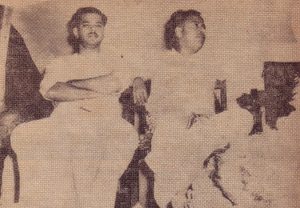
Nedunchezhiyan (lt) with Anna (rt) in a stage – circa 1940s
Chronicling briefly his interactions with Anna, Nedunchezhiyan wrote in his 1969 eulogy to Anna, as follows: “First time I saw him in 1938 at an anti-Hindi meeting held at Chennai beach, and his speech was the sweetest I heard then. In 1943, as a student, I had the opportunity to speak ahead of him at a meeting at Paddukottai. On that year, I was involved in inviting him to Annamalai University to speak in English and Tamil. For three days, we enjoyed his company at the hostel. Others who benefitted on that opportunity were Anbhazagan and Chezhiyan. On May 1944, Anna invited me to take part at a youth conference. While he presided, I was offered the opportunity to raise the flag. Between 1944 and 1955, whenever he visited Chennai, he visited the residences where I stayed with my younger sibling Chezhiyan and spent time in discussing many issues for days.
In 1949, when DMK was founded, Anna became the general secretary, and I was made the assistant secretary for propaganda. In 1955, I was asked to take over the position of general secretary. After my win in the 1962 legislative assembly election, I was asked to lead the party as the Leader of the Opposition. Then in 1967, on Anna’s request, I assumed a Cabinet minister rank.
After inviting me in 1955 to be the general secretary of the party, what Anna wrote in ‘Dravida Nadu’ issue, indicated to me how much confidence he had in me….. Then, those kind words uttered by Anna at the 1956 party conference in Tiruchi, “Thambi Vaa! Thalaimai Erka Vaa! – Un aanaikku kaddupaddu nadakirom!” [Come on, younger brother. Come on, to lead us. We’ll respect your decision and direction.], were too mesmerizing for me to forget for ever.”
Anna’s biographer Kannan had inferred that the choice of Nedunchezhiyan by Anna in 1956, was a compromise one, because two other leading lights in the party (Sampath and Karunanidhi) had ‘apparently desired the position for themselves’. It could be so. My view is that Anna might have based the choice on chronological maturity. Karunanidhi and Sampath were 4 and 6 years younger than Nedunchezhiyan. Furthermore, in the 1953 sedition case hoisted by the Madras state government on five of DMK’s top leaders, while Anna was accused No.1, K.A. Mathialazhagan (1926-1983) was accused No.2, Sampath (1926-1977) was accused No.3, Nedunchezhiyan was accused No. 4. Karunanidhi was not indicted. Like Sampath, Mathiazhagan was also 6 years younger to Nedunchezhian. Accused No.5 was N.V. Natarajan (1912-1975).
In his deposition on behalf of DMK’s activity on this trial, Nedunchezhian noted, “That the Government cannot find anything, objectionable and lawfulness in the resolutions and the programmes of our party…When the Congress movement was agitating against the British domination it devised certain modes of agitations. The same Congress is in power now, both in the State and the Centre. The same ways of the Congress are now used by us. To see signs of Congress Government, calling its own devices as unlawful…Picketing is allowed by the Constitution and hence the DMK resolved to organize the picketing in a constitutional, peaceful and non-violent way…As for stopping of the trains apart from the object of protesting against the remarks of the Prime Minister there was no intention on our part to cause inconvenience or to be unlawful in our action.”
Electoral Performance
Nedunchezhiyan’s performance in Madras (and later Tamil Nadu) legislative assembly elections have been of interest to me, because of his ‘outlier’ status of not identifying himself with cinema glamor. In this sense, he differed from Karunanidhi and MGR, both of whom never lost an election.
Between 1957 and 1996, Nedunchezhiyan contested in 9 legislative assembly elections, winning in six and losing in three. First four elections (1957, 1962, 1967 and 1971), he contested in DMK party ticket. In subsequent five elections, in four (1980, 1984, 1991 and 1996) he contested as Anna DMK party candidate. In the aftermath of MGR’s death, and the Anna DMK party split in two camps (that of Janaki Ramachandran and Jayalalitha), Nedunchezhiyan formed an independent ‘grouping of Four’ (Naalvar Ani) to contest the 1989 election and lost badly, forfeiting deposit.
The results of these elections, and my annotations are follows:
1957: constituency Salem I (#42) – date March 1, 1957
Mariappan (Indian National Congress) – 24,920 votes
V.R. Nedunchelian (Independent) – 24,713 votes.
victory margin for Mariappan 207 votes.
As this was the first time, DMK was contesting in an election, the party didn’t receive recognition by the Electoral Commission. As such, it’s candidates had to contest as independents. This caused a disadvantage to DMK candidates. The choice symbol of ‘rising sun’ was not given all its candidates. To a few like Nedunchezhiyan and Kannadasan the allotted symbol was ‘cockerel’. The confusion caused to the voters by candidates of the same party contesting with different symbols in different constituencies became a drawback to Nedunchezhiyan, and he lost by a whisker of 207 votes.
For the next three elections, Nedunchezhiyan was nominated as a DMK candidate in a suburb of Chennai – Thiruvallikeni (Triplicane). He won consecutively in this constituency, though his reduced victory margin in the 1971 election did cause concern to party leader Karunanidhi.
1962: constituency Triplicane (#8) – date February 19, 1962
V.R. Nedunchezhiyan (DMK) – 33, 273 votes
Sivanesan (Indian National Congress) – 22,903 votes
victory margin for Nedunchezhiyan 10,903 votes.
As DMK leader Anna was defeated by a bus company magnate S.V. Natesa Mudaliar of Cogress Party, in the elections contesting the Kancheepuram constituency, Nedunchezhiyan was chosen to lead the DMK group of 50 members, and functioned as the Leader of the Opposition, though he had won the elections for the first time.
1967; constituency Triplicane (#9) – date February 21, 1967
V.R. Nedunchezhiyan (DMK) – 38,721 votes
M.S. Dammandappa (Indian National Congress) – 26,027 votes.
victory margin for Nedunchezhiyan 12,694 votes.
Nedunchezhian was able to retain the same constituency for the 2nd time. Anna died on February 3, 1969. Though Nedunchezhian functioned as the acting chief minister for 6 days of post-Anna period, Karunanidhi with his organizational talent beat him for the DMK leadership and the eventual chief minister position. Karunanidhi, in his autobiography, portrayed himself as being drafted by majority of the party members (including MGR) against the wishes of his family and him, to lead the party. Thus, Nedunchezhian was forced to accept such a decision. But, according to poet Kannadasan’s version, in reality, this was not so. Being outsmarted by his junior colleague, Nedunchezhian held out for few months, in not accepting Karunanidhi’s plea to join his Cabinet, as Number 2. Eventually, Nedunchezhian did accept the reality and joined Karunanidhi’s Cabinet.
1971: constituency Triplicane
V.R. Nedunchezhiyan (DMK) – 36,237 votes
Vinayakam (National Congress-Old) – 35,198 votes
victory margin for Nedunchezhiyan 1,039 votes.
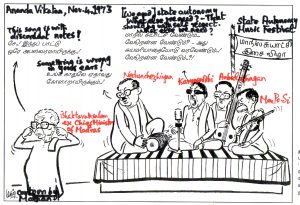
DMK Concert in 1973 cartoon by Mathan
DMK faced the first election, after the death of it’s founder leader Anna. Nedunchezhiyan was able to scrape through in this election, with a largely reduced victory margin. Karunanidhi wrote in his autobiography, during the vote count, there was a scare in party circles, that Neduchezhiyan may lose. When conflict erupted between Karunanidhi and MGR on the future direction of DMK, according to Karunanidhi, it was Nedunchezhian who demanded strongly that MGR should be removed from the party.
A Mathan cartoon in 1973, that appeared in the Ananda Vikatan shows, how Nedunchezhiyan played the No.2 role to Karunanidhi’s ‘State Autonomy’ call to the the Central government (led by Indira Gandhi), after 1971. Karunanidhi is giving a vocal concert, with the song ‘[We need] state autonomy…what else we need? – That should be with self respect. What else we need?’ Ma.Po. Si (who was the first raise this political plank) plays violin. While Nedunchezhian plays mridangam, Anbalazhagan plays tambura. Listening M. Bhaktavathsalam (ex chief minister of Madras state, belonging to Congress Party) with fingers inside his ears, says, ‘This song is with discordant notes!’. To this, Nedunchezhian responds, ‘Something is wrong in your ears!’. Eventually, the relationship between Nedunchezhian and Karunanidhi did suffer. We can hardly infer, who was at fault for this outcome? Four years later, prior to the June 1977 general election, Nedunchezhiyan left the DMK party and formed his own party in April 1977.
In early 1970s (after MGR was expelled from the DMK, Karunanidhi’s Cabinet consisted of 13 individuals, including him. Among the 12 (Nedunchezhian, K. Rajaram, K. Anbalzhagan, Anbil P. Dharmalingam, N. V. Natarajan, S.P. Adithan, S.J. Sadiz Pasha, Satyavani Muthu, M. Kannappan, S. Madhavan, Panruti S. Ramachandran and O.P. Raman), six left DMK by 1977. While senior leader N.V. Natarajan (1912-1975) had died in 1975, those who left DMK include Nedunchezhian, Rajaram, Satyavani Muthu, Madhavan, Adithan and Panruti Ramachandran. This fact indicates that apart from Nedunchezhian, quite a number had difficulties to adapt to the grip Karunanidhi had in conducting party affairs.
1977 election
A news item appearing in the Ananda Vikatan of May 1, 1977, reported the ‘disappearing act’ of Nedunchezhian from Chennai, for a week. “After announcing that he’ll quit DMK party, he disappeared for a week. Then, he answered the questions from reporters. He told the assembled,
‘None held me prisoner. I wanted solitude. Then, I could think clearly. If I had been here, you would have confused the situation by printing reports one rebutting the other.. I stayed in Bangalore with my friend, a professor from a law college.’
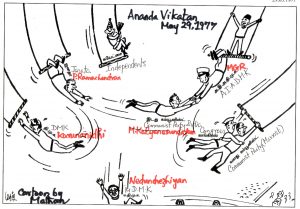
Election Circus in 1977 – cartoon by Mathan
On commenting about a newspaper’s printed story that he had gone on honeymoon with my wife, he said ‘That’s fine as well. My honeymoon has been continuing for 27 years. I do not claim that I left DMK to purify it. They could say that ‘in the absence of dirt, how could one purify it?’ There, the range of functioning democracy is very limited. Those who remain there, let them take their own route. I left [the party], not to hinder their thoughts.’
Very next day saw the birth of a new party Makkal DMK.”(Makkal = people, in Tamil). His associates were S. Madhavan, K. Rajaram and newspaper magnate S.B. Adithan. Madhavan and Rajaram were DMK’s old hands. Another Mathan cartoon in Ananda Vikatan of May 29, 1977, portrayed the electoral politics of different parties in the Tamil Nadu as a circus act.
As people didn’t warm up to this new breakaway party, Nedunchezhian merged the party with MGR’s Anna DMK in September 1977. MGR (Anna DMK) is picking up Communist Party of India guy M. Kalyanasundaram. Karunanidhi (DMK) has missed the bar. Congress Party and Communist Party (Marxist) as pairs are holding one bar. Nedunchezhian (with his new party MDMK) is shown as falling down with no helping hands.
In February 1980, when MGR’s government was toppled by Indira Gandhi, quite a chunk of Cabinet members deserted Anna DMK party. Nanjil Mahoharan (then No.2 for MGR), Soundarapandian, G.R. Edmund, K. Narayanaswami Mudaliar, Subbulakshmi Jagadesan, P.T. Saraswathi, and Aravinda Bala Pazhanoor. Many of them returned to Karunanidhi’s fold. The chief complaint they had was MGR ‘continuously insulted, ignored and humiliated’ them and treated them like clerks and kept them under surveillance. But, Nedunchezhian stood by MGR’s side and predicted to the public saying, ‘The party will not disintegrate and MGR is bent on avenging the dismissal of his government. MGR is a totally different man today.’ His predictions did come true.
Though it has been written that MGR didn’t bother to consult with Nedunchezhian in taking his major decisions, he opted to keep Nedunchezhian on his side, as his ‘one person think tank’. Unlike those Cabinet colleagues mentioned above, Nedunchezhian didn’t betray the trust and didn’t leave MGR in a huff (like what Nanjil Manoharan did in 1980 or S.D. Somasundaram did in 1984). To be fair by MGR, many in the movie field had recorded that he was a stern task master, and those who were slacking in their assigned duties would get ignored by him. As such, those who were basking on MGR’s glory with their Cabinet positions might have found it troublesome to hold on to MGR, but not Nedunchezhian.
1980: constituency Tirunelveli (#218) – date May 31, 1980
V.R. Nedunchezhian (Anna DMK) – 48, 338 votes
Rajathi Kunchithapatham (Indian National Congress –Indira) – 34,142 votes
victory margin for Nedunchezhian 14,196 votes
Nedunchezhiyan moved away from Chennai, and contested in the south. He was elected for the first time in Anna DMK ticket.
1984: constituency Athoor (#149) – date December 24, 1984
V.R. Nedunchezhiyan (Anna DMK) – 67,178 votes
Rajambal (DMK) – 37, 605 votes.
victory margin for Nedunchezhiyan 29,573 votes.
While MGR was in New York undergoing treatment, Nedunchezhiyan was nominated as the acting Chief Minister on November 16, 1984 and held this rank until February 9, 1985 (MGR’s return to Chennai, and assumption of his third tenure). For the December 1984 election, Nedunchezhiyan moved from Tirunelvely constituency to Athoor constituency and got elected in Anna DMK ticket for the 2nd time. As MGR was away from Tamil Nadu, in collaboration with MGR’s ‘man Friday’ – R.M. Veerappan (RMV), Nedunchezhian did play a marked role in the choice of party candidates and was successful in getting a majority for the Anna DMK. As reviewed by MGR’s biographer Kannan, “Nedunchezhian commanded little following and his fate too, despite his seniority, hung in RMV’s hands. For now, they seemed to need each other. Nedunchezhian’s seniority and status as number two in the ministry helped him serve as a frontman. Moreover, Nedunchezhian, never known for his organizational abilities or following, hoped to use RMV to finally reach the pinnacle of power, if and when the occasion arose.
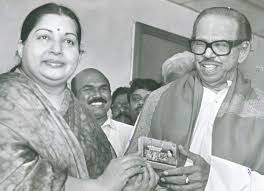
Jayalalitha and Nedunchezhian
After MGR’s death in December 1987, Nedunchezhiyan for the third time in his political career was nominated as the acting Chief Minister on December 25, 1987 and continued until January 6, 1988. He hoped to assume chief minister position that had eluded him since 1969, and informed so to the media on December 28th. But he couldn’t present amble hands in the party who were willing to support his candidacy. The party established by MGR was pulled in opposite directions by MGR’s vigilant image maker Veerappan (who opted to present MGR’s wife Janaki) as the future hope, and Jayalalitha. As some of Tamil Nadu political wiseacres ridiculed then, in this ‘Battle between MGR’s wife and paramour’, Nedunchezhiyan lost out. Nevertheless, Nedunchezhiyan, in association with few colleagues (C. Aranganayagam, Panruti Ramachandran, S. Thirunavukarasu and K.K.S.S.R. Ramachandran) sided with Jayalalitha to project her as the general secretary of the party. By mid July 1988, Neduchezhiyan, Aranganayagam, Thirunavukarasu and Panruti Ramachandran, were expelled by Jayalitha. Then, they formed their own ‘Front of Four’ [Naalvar Ani] grouping. This indeed was an ill-advised move to harp on their long standing proximity to MGR. Sadly, within the next six months, conflict among these four dispersed the group. Thirunavukarasu was the first to leave, and join Jayalalitha’s ADMK on November 16, 1988. Nedunchezhian then announced on December 15, 1988 that Panruti Ramachandran was being relieved from his rank as the general secretary of the group, and temporarily Aranganayagam would look after that role.
Nedunchezhian wanted to try his luck in the 1989 election as an independent, devoid of party labels. And he was rejected by the voters of Mylapore constituency. Among 20 candidates, he placed 7, with a pitiful 596 votes (0.5% of the votes polled in this constituency). This was the nadir point of Nedunchezhiyan’s political career.
1989: constituency Mylapore (#13)
Ganapathy (DMK) – 48,461 votes
Sarojini Varadappan (Anna DMK – Jayalalitha faction) – 30,266 votes
S.K. Viswanathan (Anna DMK – Janaki Ramachandran faction) – 27,764 votes
V.R. Nedunchezhiyan (Independent) – placed 7 – 596 votes!
As one could note in the election results of Mylapore, in quite a number of constituencies, the votes of Anna DMK were split equally, and because of this, Karunanidhi-led DMK was able to win a higher number of seats, to be returned again as the Chief Minister of Tamil Nadu, after more than 11 years. Never thinking of returning to the fold of DMK again, somehow, Nedunchezhiyan gulped his pride and joined Jayalalitha-led Anna DMK again. Though there had been harsh exchange of accusations between Jayalalitha and Nedunchezhiyan in 1988, Jayalalitha was gracious enough to accommodate him. To guard herself against the verbal pyrotechnics of her bete noire Karunanidhi and his associates, Jayalalitha badly needed a senior politician (who had been a founder member of DMK) who could give ‘guidance’ to her party. Nedunchezhiyan’s stature (but not the popularity with the Tamil masses) perfectly fitted this need. But, whether Jayalalitha listened to Nedunchezhiyan is another issue.
1991: constituency Theni (#132)
V.R. Nedunchezhiyan (Anna DMK) – 67,739 votes
L.S.R. Krishnan (DMK) – 26, 439 votes
victory margin for Nedunchezhiyan 41,300 votes
In the aftermath of the assassination of Rajiv Gandhi in May 1991 at Sri Perumbudur, that dumped Karunanidhi and DMK, at the age of 70 years, Nedunchezhiyan was able to win the Theni constituency with the best performance of his political career with a victory margin of over 40,000 votes.
1996: constituency Theni (#132)
N.R. Alagaraja (Tamil Manila Congress) – 77,522 votes
V.R. Nedunchezhiyan (Anna DMK) – 28,378 votes
victory margin for Alagaraja 49,144 votes.
Contesting in the same Theni constituency that he had won in 1991, Nedunchezhian lost in the 1996 election, in the DMK avalanche.
To summarise Nedunchezhiyan’s electoral performances, he contested 6 constituencies (Salem, Triplicane, Thirunelveli, Athoor, Mylapore and Theni) in 9 general elections. Among the six, he could win in Triplicane constituency three times consecutively. At the Theni constituency in 1990s, he won one and lost one. Due to the vagaries of party selections, Nedunchezhiyan couldn’t nurture one particular constituency for over 40 years. Suppose if he had chosen this strategy, he might have avoided the two defeats in 1989 and 1996 elections.
A Person of Merit
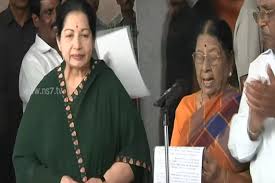
Jayalalitha and Dr. Visalakshi Nedunchezhian
As a politician, Nedunchezhiyan was not without faults. He had his vanities and did pay for them. One criticism thrown on him was that he was a hen-pecked husband (as presented by one reporter R.S, in the aftermath of MGR’s death, and the power struggle in the Anna DMK party, in January 1988). In comparison to many of his contemporary politicians in Tamil Nadu who were open and closet bigamists, isn’t it far better, being a hen-pecked husband? With restraint, one could say that he recognized and accommodated his wife’s views favorably. Thus, in a mileau dominated by wife battering husbands, he might have been a man ahead of his times. Nedunchezhiyan’s wife Dr. Visalakshi Nedunchezhiyan (1924-2016) was a qualified gynecologist, and did enter politics after his death. She joined Anna DMK party (to which her husband belonged to), and functioned in various capacities for more than a decade.
As a person of merit for his contribution to Tamil culture in the 20th century, Nedunchezhiyan ranks above top 90 percent. Even his adversaries cannot deny that Nedunchezhiyan did elevate Tamil oratory to an art form. Apart from this, he also authored numerous books and booklets in Tamil. To mention a few among these: Ezhuchi Murasu (Rising Drum), Puthiya Paathai (New Path), Mozhi –p-Porattam (Battle of Language), Kanneerum Chenneerum Valartha Kazhagam (Kazhagam bred by Blood and Tears), Kalithohai Kanda Kathal Kaatchigal (Love scenes from Kalithohai), Pandai Grekkam (Ancient Greece), Mooda Nambikkai (False Beliefs), Samuthaya Viduthalai (Societal Liberation), Purananooru Katchikal (Scenes from Purananooru), and Thi-Mu-Ka (DMK). In his salad days, Nedunchezhiyan, with cooperation from his younger sibling Chezhian, also ran a Tamil journal, ‘Mandram’ for few years. Unfortunately, I haven’t seen an issue of this magazine. Nevertheless, it’s my hope that Nedunchezhian’s public contributions deserve something better than what appears in the digital records now.
Cited Sources
Anon: ‘Mahanukku penn parka povathaha sonnavar…’[The one who told that he was looking at a bride for his son…] Ananda Vikatan, May 1, 1977.
Anon: ‘A Fallen idol’. India Today, May 1-15, 1980, p. 34
- Kannan: Anna – The Life and Times of C.N. Annadurai, Penguin Books India, New Delhi, 2010.
- Nedunchezhiyan: Arignar Annavin anbu ithayam [Kind heart of Arignar Anna]. Ananda Vikatan, Mar 30, 1969 issue, pp. 18-21.
R.S:Two men, two women. The Week, Jan.10, 1988.
file:///G:/Anna%20DMK%20after%20MGR,%20The%20Week,%20Jan.%2010,%201988.pdf
A.S. Venu: Verdict on Verdict (Trial of Dravidian Leaders – C.N. Annadurai, K.A. Mathialagan, E.V.K. Sampath, R. Nedunchelian, N.V. Natarajan), Kalai Manram, Madras, 1953.
Wow, I never thought Nedunchezhiyan had such a great legacy. I always thought he is just another politician. Thanks Dr. Sachi for documenting the entire character of this legend who always had only a shallow public image.